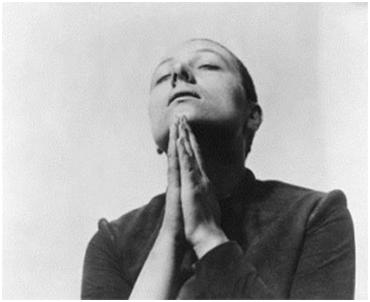Last night, I enjoyed the greatest film/live music experience of my 40+ years as a silent film aficionado. The film was Carl Theodor Dreyer’s The Passion of Joan of Arc. The music was Richard Einhorn’s Voices of Light, “An Oratorio with Silent Film.” Mark Sumner conducted the 22-piece orchestra and approximately 180 singers from multiple choruses. The overall effect was powerful, entrancing, awe-inspiring, frightening, and beautiful.
Let’s start with the motion picture itself.
Based on transcripts from Joan’s 15th century trial for heresy, Dreyer’s film concentrates on people–not  myths. Renée Jeanne Falconetti plays Joan as an illiterate, 19-year-old peasant girl in way over her head and terrified (the actress was well into her thirties when she played the role). Joan tries to draw strength from her strong and profound religious faith, but faced with intimidation and threats of torture and death, that faith waivers. Falconetti captures the young girl’s fear, determination, piety, ignorance, and confusion in a performance of startling depth and intensity. And all without use of her voice.
myths. Renée Jeanne Falconetti plays Joan as an illiterate, 19-year-old peasant girl in way over her head and terrified (the actress was well into her thirties when she played the role). Joan tries to draw strength from her strong and profound religious faith, but faced with intimidation and threats of torture and death, that faith waivers. Falconetti captures the young girl’s fear, determination, piety, ignorance, and confusion in a performance of startling depth and intensity. And all without use of her voice.
With one exception, the church dignitaries who oversee her trial show little sympathy for her plight. Yet the way they react to Joan and her dilemma differs. Some are dignified, others mocking. With some, you wonder if they might be feeling just a tad guilty.
Dreyer has set up a conflict between religion as pure and simple faith, and religion as bureaucracy. All of the characters are devout Catholics. But while Joan believes because she has heard voices, seen angels, and thinks that God has a mission for her, the judges believe because the Church has placed them above everyone else. Someone who claims to be taking orders directly from God is a threat to their power as intermediaries. Dreyer pretty much ignores the England vs. France political issues involved in the actual trial.
No other filmmaker loved the human face like Dreyer. Passion is a symphony of close-ups and tight two-shots, many from odd and dramatic angles, and often shot against blank backgrounds. The camera often moves, panning from one striking close-up to another. This isn’t just showing off, as it arguably is in Last Year at Marienbad. Dreyer uses his unusual style to pull us into the characters, emphasize the bizarre reality of the true story, and heighten the
emotional effect.
And speaking of emotional effect, there’s that music.
Richard Einhorn composed Voices of Light in 1994, both as a score for Passion and as a separate work that stands on its own. Either way, it’s about religion, and about Joan of Arc.
Musically, it’s about voices. There’s a great deal of singing in this piece, all by large choruses and in Latin, old French, and old Italian. For a monolingual English-speaker like myself, the singing evokes piety and worship, but I have no idea what’s actually being said. I do know that, in last night’s performance, the choral group Perfect Fifth sung the part of Joan.
This wasn’t a presentation where the music supported the movie or the movie illustrated the music. It was something different entirely. Both the music and the movie are great works of art that can stand alone, but blended together, they create an altogether unique and powerful meditation on faith and oppression.
I won’t be forgetting this one for awhile.
Last night’s performance was a co-production of the San Francisco Silent Film Festival, the Pacific Film Archive, and the Oakland Paramount (which has, by the way, fantastic acoustics for this sort of thing).

2 thoughts on “Voices of Light & The Passion of Joan of Arc”
Comments are closed.